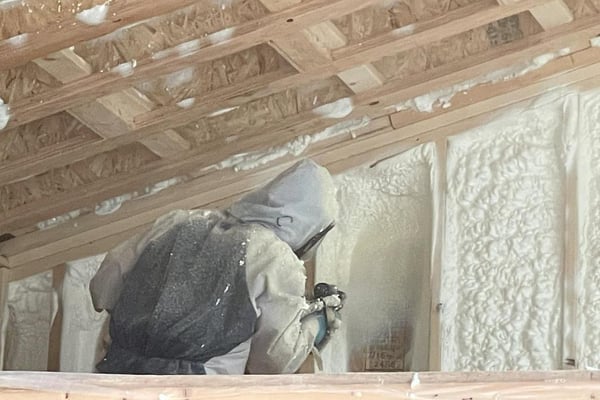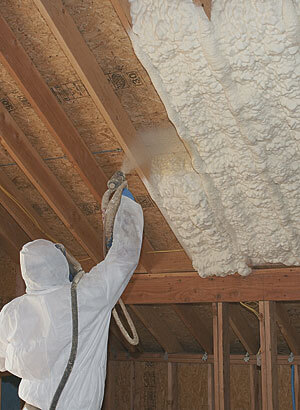Understanding the Benefits of Using Spray Foam for Insulation Projects
Understanding the Benefits of Using Spray Foam for Insulation Projects
Blog Article
Spray Foam: The Ultimate Service for Air Sealing and Insulation
Spray foam insulation has actually become a leading service for efficient air securing and thermal insulation, offering a special mix of homes that establish it in addition to conventional techniques. Its capacity to increase and fill up voids makes it particularly effective in stopping air leak, which can dramatically impact energy efficiency. Comprehending the full range of its benefits, setup processes, and comparisons with other insulation types is essential for making notified decisions. As we explore these aspects, the implications for both new constructions and retrofits become increasingly significant. What factors should affect your selection?
What Is Spray Foam?
Spray foam is a functional insulation material that combines the concepts of air sealing and thermal resistance to enhance power effectiveness in buildings. Made up mostly of polyurethane or other comparable substances, spray foam is used as a liquid that increases upon call with surfaces, developing a solid, continuous layer of insulation. This one-of-a-kind residential property enables it to fill voids, cracks, and gaps that standard insulation materials might overlook, giving a remarkable air seal.
There are two primary sorts of spray foam: open-cell and closed-cell. Open-cell spray foam is lighter and a lot more flexible, supplying outstanding audio absorption and a lower R-value per inch - Spray Foam. In comparison, closed-cell spray foam is denser, offering a greater R-value, moisture resistance, and included structural stability to constructing elements
The application procedure usually entails specialized devices, ensuring a smooth application that follows various substratums, consisting of concrete, timber, and steel. This flexibility makes spray foam suitable for both new buildings and retrofitting existing frameworks. Its ability to produce an impermeable barrier considerably adds to reducing energy usage and boosting interior air quality, thus making it a favored selection amongst home owners and builders alike.
Benefits of Spray Foam Insulation
One of one of the most significant advantages of spray foam insulation is its outstanding capacity to develop a continuous air barrier, which effectively reduces energy loss. Unlike conventional insulation materials, spray foam broadens to fill up fractures and spaces, making sure that air leakage is considerably reduced. This particular not only enhances power performance yet additionally brings about decrease energy expenses in time.
Furthermore, spray foam insulation offers superior thermal resistance, adding to an extra secure interior atmosphere. Its high R-value per inch enables effective insulation in constrained rooms, making it suitable for attics, walls, and crawl rooms. The moisture-resistant homes of spray foam help protect against mold and mildew and mildew development, promoting healthier living problems.
One more critical advantage of spray foam insulation is its sound-dampening high qualities (Spray Foam). It effectively minimizes noise transmission in between spaces, developing a quieter and a lot more comfortable home atmosphere. The resilience of spray foam additionally sticks out, as it does not sag or clear up over time, keeping its efficiency throughout its life expectancy
How Spray Foam Functions
Understanding exactly how spray foam insulation functions is vital for valuing its efficiency in air securing and thermal resistance. Spray foam insulation contains 2 key elements: isocyanate and polyol material. When these components are blended, they undertake a chain reaction that triggers the product to expand quickly, developing a dense foam that fills up voids, cracks, and tooth cavities.
As the foam expands, it complies with surfaces, developing an impermeable seal that significantly decreases air seepage. This particular makes spray foam insulation very effective at avoiding drafts and click over here wetness infiltration, which can bring about power loss and damages over time. Additionally, the closed-cell variation of spray foam uses remarkable thermal resistance as a result of its inflexible framework, effectively minimizing warmth transfer.
The special properties of spray foam allow it to satisfy irregular surfaces, guaranteeing extensive protection and a seamless barrier. Because of this, spray foam insulation not only enhances power performance yet additionally adds to boosted interior air high quality by decreasing the accumulation of toxins and irritants. Inevitably, comprehending the mechanics behind spray foam emphasizes its duty as a premium choice for insulation and air sealing in both commercial and household applications.
Installation Refine Introduction

Before installment, the space should be appropriately cleaned up and prepped, making certain that surfaces are without wetness, dirt, and particles. Since pollutants can endanger attachment and overall performance, this step is important. As soon as the location is prepared, the application look what i found entails blending the two components of the spray foam, which expands upon get in touch with and fills up spaces successfully.
Educated specialists need to perform the installment, utilizing specialized equipment to ensure uniform coverage and optimal density. Safety precautions, consisting of putting on safety equipment and making certain correct ventilation, are important during this process. After application, the foam generally cures quickly, forming a strong obstacle that improves energy efficiency.
Contrasting Spray Foam to Typical Insulation
When reviewing insulation alternatives, spray foam insulation stands out in contrast to traditional materials such as fiberglass and cellulose. Unlike fiberglass and cellulose, which can permit air infiltration, spray foam increases upon application, filling up crevices and voids to develop a closed seal.
Additionally, spray foam gives a higher R-value per inch than typical insulation types, supplying more reliable thermal resistance in a thinner profile. This particular is especially beneficial precede with limited tooth cavity depth. Moreover, spray foam is immune to wetness and mold and mildew growth, which can be a considerable worry about cellulose and fiberglass, especially in moist environments.
Nonetheless, spray foam insulation generally brings a greater upfront expense than its standard equivalents. Property owners need to consider this initial investment against long-lasting power financial savings moved here and performance benefits. Eventually, while both insulation kinds offer their objective, spray foam arises as a more sophisticated option for modern-day insulation demands, specifically in terms of air sealing and thermal efficiency.

Final Thought
In summary, spray foam insulation represents a highly effective solution for achieving optimal air securing and thermal resistance. Its unique residential or commercial properties, including moisture resistance and audio dampening, make it suitable for various applications in both brand-new building and constructions and retrofitting tasks (Spray Foam). The first prices may be greater contrasted to conventional insulation materials, the lasting advantages, such as considerable energy financial savings and enhanced indoor air top quality, validate the investment and emphasize its value in modern-day building practices.
Spray foam insulation has actually emerged as a leading remedy for efficient air securing and thermal insulation, using a distinct mix of residential properties that set it apart from typical techniques.Spray foam is a functional insulation material that incorporates the principles of air securing and thermal resistance to enhance power efficiency in structures.When evaluating insulation alternatives, spray foam insulation stands out in comparison to standard materials such as fiberglass and cellulose. Eventually, while both insulation kinds serve their function, spray foam arises as a much more innovative service for contemporary insulation needs, especially in terms of air securing and thermal efficiency.
In summary, spray foam insulation stands for a highly efficient remedy for achieving ideal air securing and thermal resistance.
Report this page